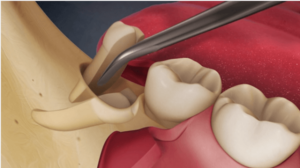Lower wisdom teeth can be particularly troublesome when they grow misaligned, become impacted, or cause pain and infection. Many individuals worry about the risks involved in extracting lower wisdom teeth due to their sensitive location near nerves and other critical structures. However, with advancements in dental techniques, wisdom tooth extraction has become a routine and safe procedure. In this comprehensive guide, Joy International Dental Clinic will walk you through everything you need to know about lower wisdom tooth extraction, including when it is necessary, the potential risks, and the most effective treatment methods.
1. When Should You Remove a Lower Wisdom Tooth?
Not all wisdom teeth require extraction, but there are several situations where removal is essential to prevent severe dental complications.
1.1 Cases Requiring Lower Wisdom Tooth Extraction

- Impacted Wisdom Teeth: If the tooth is trapped under the gums or growing at an improper angle, it can press against adjacent teeth and cause pain, swelling, or infection.
- Overcrowding and Misalignment: Lack of space in the jaw can lead to overcrowding, shifting other teeth out of alignment and potentially requiring orthodontic treatment.
- Tooth Decay and Gum Disease: Wisdom teeth are difficult to clean due to their location, making them prone to cavities and gum infections, which can spread to neighboring teeth.
- Pericoronitis (Gum Inflammation): Partial eruption of wisdom teeth can create a pocket where food and bacteria accumulate, leading to painful gum infections.
- Formation of Cysts or Tumors: In rare cases, impacted wisdom teeth can cause cysts or benign tumors, which may damage the jawbone and surrounding structures.
- Chronic Pain and Swelling: Persistent discomfort, jaw stiffness, or headaches associated with a problematic wisdom tooth often indicate the need for extraction.
- Infection and Abscesses: Untreated infections around the wisdom tooth can lead to abscess formation, which poses serious health risks if not addressed promptly.
- Dentist’s Recommendation: Some dentists advise preventive removal of wisdom teeth even before complications arise, particularly for individuals with a small jaw structure.
1.2 Cases Where Extraction is Not Necessary
- Properly Aligned Wisdom Teeth: If the tooth emerges correctly and does not interfere with adjacent teeth, it may not require removal.
- No Signs of Decay or Infection: A wisdom tooth that remains healthy and does not cause pain or inflammation may be left in place.
- Medical Conditions That Pose Risks: Individuals with bleeding disorders, diabetes, or pregnant women should consult their healthcare provider before opting for surgery.
- Fully Functional Wisdom Teeth: In rare cases where the wisdom tooth serves a purpose in chewing and has sufficient space, extraction may not be required.
2. Is Lower Wisdom Tooth Extraction Dangerous?

Lower wisdom tooth extraction is a standard dental procedure, but as with any surgery, it carries potential risks. The following are some possible complications:
- Bleeding: Excessive bleeding may occur, particularly in individuals with clotting disorders or those taking blood thinners.
- Nerve Damage: The lower wisdom teeth are close to the inferior alveolar nerve. If damaged, it can cause temporary or permanent numbness in the lips, chin, or tongue.
- Dry Socket: If the blood clot at the extraction site dislodges prematurely, it can result in severe pain and delayed healing.
- Infection: Poor oral hygiene or failure to follow post-extraction care instructions can lead to bacterial infections at the surgical site.
- Swelling and Pain: While common, these symptoms can be effectively managed with prescribed medication and cold compresses.
- Jaw Stiffness: Some individuals may experience temporary difficulty in opening their mouth due to muscle tension and swelling.
- Sinus Complications: In rare cases, an upper wisdom tooth extraction may lead to sinus perforation, requiring additional treatment.
These risks are significantly minimized when the procedure is performed by a skilled dentist at a reputable clinic using advanced techniques.
3. Advanced Techniques for Lower Wisdom Tooth Extraction
Modern dentistry offers several methods to make wisdom tooth extraction safer, less painful, and promote faster recovery.
3.1 Traditional Surgical Extraction

This method involves making an incision in the gum, removing bone if necessary, and extracting the tooth using forceps. It is effective but may result in more swelling and a longer recovery time.
3.2 Ultrasonic (Piezoelectric) Wisdom Tooth Extraction

A more advanced technique uses ultrasonic vibrations to precisely cut and loosen the tooth while minimizing damage to soft tissues. This method offers several benefits:
- Less Pain and Swelling: Reduced trauma to surrounding tissues results in a more comfortable recovery.
- Lower Risk of Bleeding: Minimally invasive techniques help control bleeding during surgery.
- Faster Healing: Patients generally experience quicker recovery compared to traditional methods.
- Greater Precision: Ultrasonic technology allows dentists to remove the tooth with high accuracy, reducing the risk of complications.
4. Essential Pre-Extraction Considerations

Proper preparation ensures a smooth and safe wisdom tooth removal experience. Follow these guidelines before undergoing extraction:
- Choose an Experienced Dentist: Selecting a skilled and reputable dental professional minimizes risks and ensures optimal results.
- Discuss Your Medical History: Inform your dentist about any health conditions, allergies, or medications you are taking to avoid complications.
- Follow Pre-Surgery Dietary Guidelines: Avoid alcohol, caffeine, and smoking before the procedure. Eating a light meal is recommended if sedation is not involved.
- Arrange Transportation: If receiving sedation or anesthesia, plan for someone to drive you home after the procedure.
- Understand Aftercare Instructions: Familiarize yourself with post-extraction care, including proper oral hygiene and medication usage, to promote healing.
- Wear Comfortable Clothing: Loose-fitting clothes and short sleeves make it easier to monitor vital signs if necessary during the procedure.
5. Post-Extraction Care for a Smooth Recovery
Recovery plays a crucial role in ensuring a pain-free healing process. Follow these aftercare tips:
- Control Bleeding: Bite down on a gauze pad for 30-45 minutes to encourage clot formation. Avoid excessive spitting or rinsing.
- Manage Pain and Swelling: Use prescribed painkillers and apply ice packs in intervals of 15-20 minutes.
- Maintain Oral Hygiene: Brush gently around the surgical site and use a prescribed mouth rinse or saltwater solution to prevent infection.
- Eat Soft Foods: Stick to a diet of soups, yogurt, mashed potatoes, and smoothies for the first few days.
- Avoid Smoking and Alcohol: These can delay healing and increase the risk of infection.
- Rest and Avoid Strenuous Activities: Give your body time to recover by limiting physical exertion.
- Monitor for Complications: Contact your dentist immediately if you experience excessive pain, bleeding, fever, or signs of infection.
Conclusion
Lower wisdom tooth extraction is a safe and routine procedure when performed by a skilled dental professional using modern techniques. If you’re experiencing wisdom tooth pain or other related symptoms, visit Joy International Dental Clinic for a thorough consultation. Our experienced team ensures a painless, efficient, and professional treatment experience, helping you maintain optimal oral health.






